CDL Practice Tests: Flatbed Cargo Securement
Choose A Section:
Go!Cargo is contained when:
- it fills a sided vehicle, and every article is in contact with or sufficiently close to a wall or other articles so that it cannot shift or tip if those other articles are also unable to shift or tip.
- It is packed in a square box.
- It is loaded on the end of the truck.
- It fills a void between articles of cargo and the structure of the vehicle that has sufficient strength to prevent movement of the articles of cargo.
Contained:
Cargo is contained if it fills a sided vehicle, and every article is in contact with or sufficiently close to a wall or other articles so that it cannot shift or tip if those other articles are also unable to shift or tip.
What is the minimum requirement for securing roll-off and hook containers?
- All of these are acceptable.
- One tiedown attached to both the vehicle chassis and the container chassis.
- Two hooks, or an equivalent mechanism, securing both sides of the container to the vehicle chassis.
- Two tiedowns installed lengthwise, each securing one side of the container to one of the vehicle's side rails.
Secure to the rear of the vehicle with at least one of the following three mechanisms:
-
Rear Mechanism 1:
One tiedown attached to both the vehicle chassis and the container chassis.
-
Rear Mechanism 2:
Two tiedowns installed lengthwise, each securing one side of the container to one of the vehicle's side rails.
-
Rear Mechanism 3:
Two hooks, or an equivalent mechanism, securing both sides of the container to the vehicle chassis at least as effectively as the tiedowns in the two previous items.
When loading paper rolls with eyes horizontal, which of the following is not a requirement for stacking a second layer:
- Place second layer with eyes vertical.
- The bottom layer must extend all the way to the front.
- It must be blocked against an eye-vertical blocking roll resting on the floor of the vehicle that is at least 1.5 times taller than the diameter of the roll being blocked.
- All the wells in the layer beneath must be filled
Requirements for eyes crosswise: secure stacks of paper rolls from front-to-back movement
- Do not load paper rolls on a second layer unless the bottom layer extends to the front of the vehicle.
- Load paper rolls on higher layers only if all wells in the layer beneath are filled.
-
Secure the foremost roll in each upper layer (or any roll with an empty well in front of it) against forward movement:
- Either by placing it in a well formed by two rolls on the lower row whose diameter is equal to or greater than that of the roll on the upper row.
- Or by banding it to other rolls.
- Or by blocking it against an eye-vertical blocking roll resting on the floor of the vehicle that is at least 1.5 times taller than the diameter of the roll being blocked.
What is the minimum weight of a load of metal coils that requires specific securement practices?
- 50,000 lbs
- 5,000 lbs
- 2,268 lbs
- It depends on the size of the coils.
Size of coil
All metal coil shipments that, individually or together, weigh 2,268 kg (5,000 lb.) or more must be secured according to the specific requirements in this section.
Exception: Metal coils that weigh less than 2,268 kg (5,000 lb.) may be secured according to general securement requirements.
When using tiedowns to secure boulders, all of the following are requirements except:
- Boulders must be loaded as far back towards the rear as possible.
- Use only chain to secure large boulders.
- Tiedowns should be located in valleys or notches across the top of the boulder.
- Tiedowns must be arranged to prevent sliding across the rock surface.
Requirements
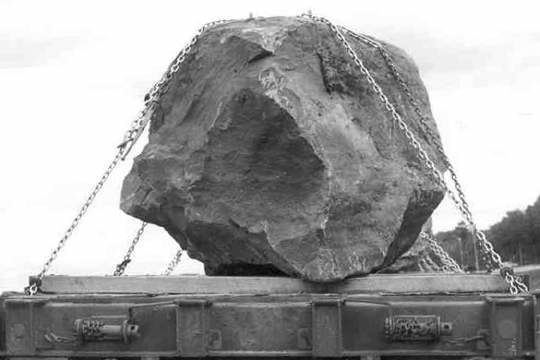
Use only chain to secure large boulders.
Tiedowns in direct contact with the boulder:
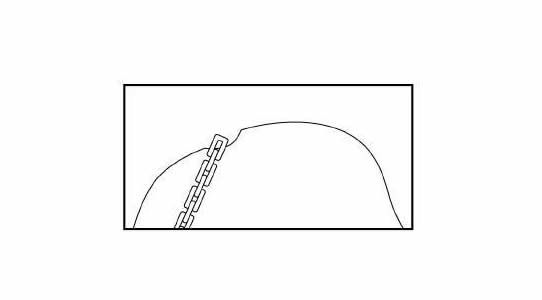
Should be located in valleys or notches across the top of the boulder
Must be arranged to prevent sliding across the rock surface.
The aggregate WLL for logs loaded lengthwise must be at least:
- 1/2 the weight of the load.
- 1/2 the weight of the stack.
- 4,000 lbs
- 1/6 the weight of the stack.
Working load limit for longwood and shortwood loaded lengthwise
The aggregate working load limit for all tiedowns must be no less than 1/6 the weight of the stack of logs.
Note: This requirement is much less than the general requirement of an aggregate working load limit equal to 1/2 the weight of the load. This lowered requirement recognizes that the bunks/stakes help to prevent slippage.
When securing rolls of paper with eyes vertical, how many points of contact are required to consider a roll secure?
- 1
- 3
- 4
- 2

Usually the roll is secure if a paper roll has 3 well-separated points of contact with the vehicle, other rolls, or other cargo.
What is the minimum Working Load Limit for the entire securement system?
- 50% of cargo weight.
- 80% of cargo weight.
- 100% of cargo weight.
- 20% of cargo weight.
Note: The minimum WLL requirement for the securement system is 50%. More tiedown capacity should be used if you need to secure an article against any movement.
When securing concrete bell pipe in multiple complete tiers, all of the following are true except:
- All of these apply.
- Stack the tiers in pyramid fashion.
- Bells of the upper tiers must all be on the opposite side of the vehicle from the bells of the tier below.
- Bells of the bottom tier must all be on the same side of the vehicle
More than one tier with complete tiers
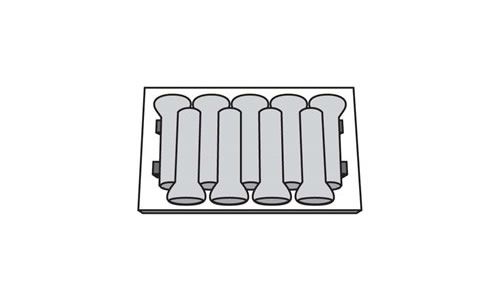
Bells of the bottom tier must all be on the same side of the vehicle
Bells of the upper tiers must be are on the opposite side of the vehicle from the bells of the tier below.
Which of these is specifically prohibited when securing crushed or flattened vehicles?
- Containment walls.
- Wire rope.
- Chains.
- Synthetic webbing.
Securement Requirements
Transport flattened or crushed vehicles so that:
- Cargo does not shift while in transit AND
- Loose parts from the flattened vehicles do not dislodge and fall from the transport vehicle
Do not use synthetic webbing to secure vehicles.
About The Flatbed Cargo Securement CDL Manual
Studying the flatbed cargo securement CDL manual is not a requirement for getting your CDL permit or license. It is required knowledge for flatbed drivers.
Some questions you should be able to answer for flatbed cargo securement:
- What is the minimum Working Load Limit of a tiedown used to secure logs?
- What is the minimum weight of a shipment of paper rolls that would require specific securement requirements?
- When securing concrete pipe over 45 inches loaded crosswise, which direction must the tiedowns on the front half of the load run?
- What is a cab shield?
- When securing concrete pipe over 45 inches loaded crosswise, which direction must the tiedowns on the rear half of the load run?
- What is a dunnage bag?
- Who is responsible for inspecting securing devices and cargo within the first 50 miles?
- How many tiedowns are required on a stack of shortwood loaded crosswise?
- What is the minimum working load limit of each tiedown used to secure crushed or flattened vehicles?
- Define 'bolster'
- What is a hook-lift container?
- When a tiedown is attached directly to the cargo, what is the ideal angle where it attached to the vehicle?
What is a securing device?
Any device specifically manufactured to attach or secure cargo to a vehicle or trailer:
- Synthetic Webbing
- Chain
- Wire rope
- Manila rope
- Synthetic rope
- Steel strapping
- Clamps and latches
- Blocking
- Front-end structure
- Grab hooks
- Binders
- Shackles
- Winches
- Stake pockets
- D-rings
- Webbing ratchet
- Bracing
- Friction mat
What is a tiedown?
A combination of securing devices that forms an assembly that:
- Attaches cargo to, or restrains cargo on a vehicle.
- Is attached to anchor point(s).
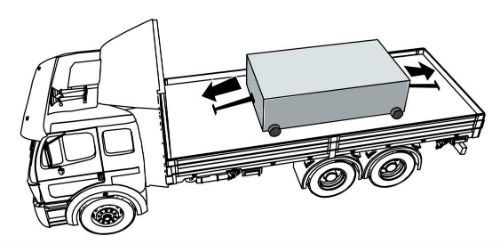
Some tiedowns are attached to the cargo and provide direct resistance to restrain the cargo from movement.
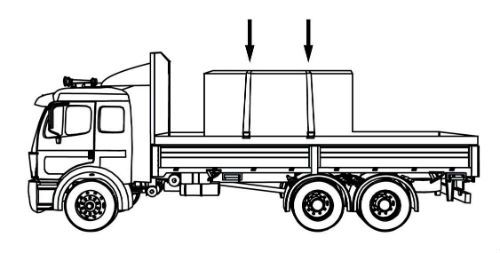
Some tie-downs pass over or through the cargo. They create a downward force that increases the effect of friction between the cargo and the deck. This friction restrains the cargo.
 Related Cargo Securement Terms That Every Driver Should Know:
Related Cargo Securement Terms That Every Driver Should Know:
-
Tiedown:
A combination of securing devices which form an assembly that attaches cargo to, or restrains cargo on, a vehicle or trailer, and is attached to anchor point(s).
-
Contained:
Cargo is contained if it fills a sided vehicle, and every article is in contact with or sufficiently close to a wall or other articles so that it cannot shift or tip if those other articles are also unable to shift or tip.
-
Blocking:
A structure, device, or another substantial article placed against or around an article to prevent horizontal movement of the article.
How should tiedowns be attached?
Tiedowns can be used in two ways:
-
Attached to the cargo:
- Tiedowns attached to the vehicle and attached to the cargo.
- Tiedowns attached to the vehicle, pass through or aroundan article of cargo, and then are attached to the vehicle again.
-
Pass over the cargo:
- Tiedowns attached to the vehicle, passed over the cargo, and then attached to the vehicle again.
Tiedown placement:

Place the tiedown as close as possible to the spacer.
Position the tiedowns as symetrically as possible over the length of the article.

Position the tiedowns to preserve the integrity of the article.







 TT On Facebook
TT On Facebook